The Origin of the Solar Wind
By Richard Woo, Shadia Habbal
A novel way of looking at the solar corona reveals a hidden "imprint" of the Sun
A novel way of looking at the solar corona reveals a hidden "imprint" of the Sun

DOI: 10.1511/2002.39.532
Nearly 1,400 years ago, Chinese astronomers noticed that comet tails always point away from the Sun. They concluded that the Sun must have a basic "life force," chi, that blows the tails away.
It wasn't until the middle of the 20th century that scientists understood that this force actually consists of little pieces of the Sun itself—mostly protons and electrons—blowing as a "wind" at more than a million kilometers per hour. The vagaries of the solar wind and other solar emanations make up what is now often called "space weather"—familiar to most of us because of its potential to devastate our technological society by shutting down power grids, damaging satellites and disrupting cellular-telephone communications. Observing space weather has become so fashionable that enthusiasts can keep tabs on the Sun at popular Internet sites such as spaceweather.com, which provide images and data of many solar phenomena, including 10-minute updates on the speed and density of the solar wind. Despite the widespread recognition of the importance of the solar wind, there is still no clear agreement on precisely where on the Sun it comes from or how it is accelerated to such dramatic speeds.
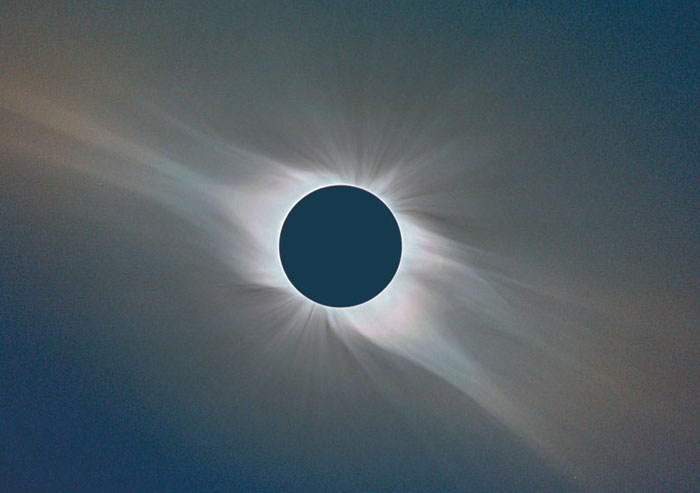
Image courtesy of Christian Viladrich, Institut d’Astrophysique de Paris-CNRS. ’
In simple terms, the solar wind is merely the extension of the Sun's atmosphere, the solar corona, which is visible to us during a total solar eclipse as the graceful veils that emanate from behind the black disk of the Moon (Figure 1). The corona can extend for millions of kilometers above the Sun's surface, but the solar wind reaches farther still, spreading outward through interplanetary space and far beyond the orbit of Pluto. And this, in part, is why it is so difficult to track its origin—scientists generally measure the solar wind near the Earth, far from its source. It's also true that if the Sun were a physically simple body the question might have been answered long ago. But its surface is mottled with regions of varying activity, which themselves interact with the corona through a complex tangle of magnetic fields and hot, ionized gas (plasma) of different densities. Which of these regions produce the solar wind? All of them, or just some?
Ideally, scientists would like to have several probes perched at various solar latitudes just above the Sun's surface. Such an array could directly relate the activity on the Sun with detailed measures of the wind's velocity, density, temperature and the Sun's magnetic field. Alas, a spacecraft has come no closer than about 50 million kilometers. And, until the Ulysses mission in 1995, all spacecraft have been confined to near the ecliptic plane (corresponding approximately to the Sun's equator). The future NASA Solar Probe mission will eventually come within 3 million kilometers of the Sun.
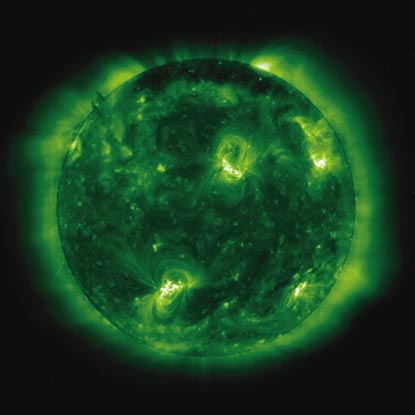
Although this is hardly an ideal situation, it is far from hopeless. In some respects the past few decades might be considered a golden era in the observation of the Sun and the solar wind. Highly successful recent spacecraft missions—Yohkoh, Ulysses, SOHO, and TRACE—have provided indispensable results and new perspectives. And there are also fundamental new developments in our understanding of the solar wind's origins that have been achieved through the use of unconventional techniques. These techniques produce results that, although not universally accepted, promise to revolutionize our understanding of the Sun and the solar wind.
The first real progress in linking the Sun and the solar wind was made in the early 1970s when rocket flights above the Earth's atmosphere measured soft x-ray emissions from the Sun. Those measurements revealed that the solar corona is a complex structure, with certain areas noticeably less dense and cooler than others. These low-density regions, named coronal holes, show up as dark areas in ultraviolet and x-ray images of the Sun (Figure 2). The dark areas are generally bounded by brighter regions, collectively called the quiet Sun, which are dotted with active regions (the sites of sunspots). For the most part, coronal holes reside at the Sun's poles, but they often extend to lower latitudes during the declining phases of the 11-year sunspot cycle (Figure 3). In contrast, coronal streamers are hot and dense, and they emanate from the quiet Sun and the active regions. During the minimally active part of the solar cycle, they generally come from the Sun's equatorial regions.
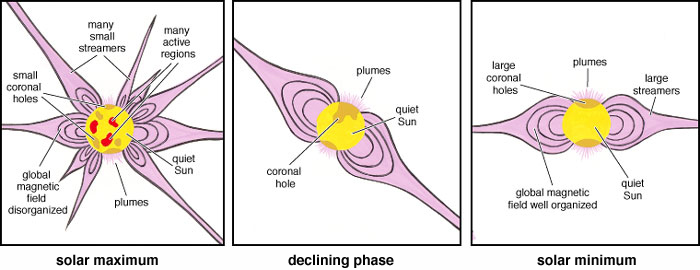
It was during one of the declining phases, when a coronal hole was directly facing the Earth, that scientists noticed that the solar wind had both fast and slow components. The fast wind was found to be cool and thin and swift, moving along at up to 800 kilometers per second, nearly twice the speed of the hot, dense slow wind. When the fast wind was mapped back to the Sun, scientists noticed that it seemed to come from the coronal holes, whereas the slow wind was eventually linked to the coronal streamers.
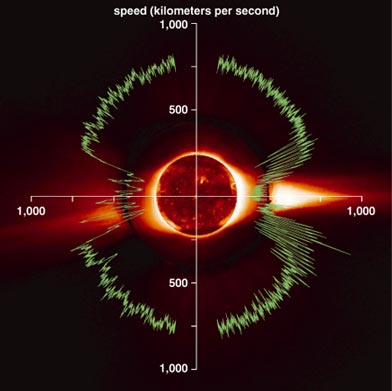
In 1995 when the Ulysses spacecraft made the first in situ measurements of the solar wind at latitudes above the ecliptic, investigators found that the fast wind prevailed over an extensive range of latitudes, not merely over the polar coronal holes (Figure 4). Many scientists concluded that the polar fast wind must be "pulled down" by the Sun's magnetic field to other latitudes. This view seems to be supported by the orientation of filamentary structures, called plumes, that emanate from the polar coronal holes. Polar plumes give the impression of open, dipole-like field lines that arc gently toward lower latitudes, and so appear to mark the path of the fast wind. In contrast, the coronal streamers have a medieval-helmet-like shape near the Sun, giving an impression of closed magnetic field lines. Such closed lines would naturally seem to hinder any wind emanating from the equatorial regions, and so explain the indolence of the slow wind.
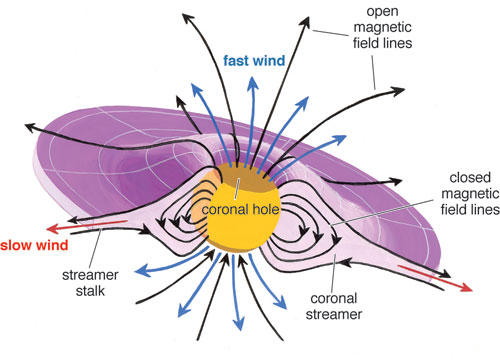
This notion has been reinforced by models of the Sun's magnetic field, which suggest the presence of open field lines in coronal holes and closed fields everywhere else (Figure 5). At the moment these models are the only links between measurements of the magnetic field on the Sun's surface and measurements of the solar wind far from the Sun. It's important to recognize that this link is entirely theoretical. Although magnetic fields near the Sun do indeed control and shape the flow of the solar wind, there are no measurements of the magnetic field in the corona. The models are used in lieu of such measurements, and this is the weak link in the conventional view of the solar wind's origins.
On February 7, 1997, engineers at NASA's Deep Space Network were given a scare when radio signals from the Galileo spacecraft were suddenly disrupted. A high-gain antenna on the spacecraft had already failed during the voyage out to Jupiter, and the success of the mission was now entirely dependent on the engineers' ability to maintain continuous radio contact by way of a smaller antenna. A system check revealed that the tracking equipment on the ground and the spacecraft's radio-transmitting system were both fully functional—the disruption didn't make a lot of sense. The failure was ultimately traced to a surprising source: the solar wind. About 20 hours before the radio disruption, the Sun spewed a glob of plasma—a coronal mass ejection—that carried a strong magnetic field across Galileo's radio-transmission path to Earth. (In 2004, radio signals from the Cassini spacecraft, which is now on its way to Saturn, will be similarly vulnerable as they pass relatively close to the Sun during a critical phase of the mission.)
The effect of the plasma on a spacecraft's radio signal is analogous to the process that makes stars twinkle in the night sky. As turbulence in the Earth's atmosphere shuffles air of various densities across the sky, light waves coming from a distant star are refracted to differing degrees and so appear to flicker. Similarly, small-scale variations in the density of the charged particles in the coronal mass ejection or the corona itself distort any radio signals that happen to be passing through. Although such disruptions wreak havoc with spacecraft communications, an analysis of the distorted signal provides another method of studying the corona because differences in the density of the plasma change the radio signal in characteristic ways.

These methods, collectively referred to as radio-occultation techniques because the corona is interposed between the source of the radio signal and the receiver on the Earth, can tell us things about the solar wind that white-light pictures of the solar corona cannot. This is partly because radio-occultation techniques can provide a "view" of the outer corona that is outside the field of view of white-light images, but also because they see smaller and fainter structures.
One of the radio-occultation techniques that we use is based on the round-trip travel time of a signal from the Earth to a spacecraft and back again (Figure 6, left). Since radio waves in free space propagate at the speed of light, the signal's travel time is a measure of the spacecraft's distance from the Earth. When such a signal passes through the solar corona, the electrons in its path alter the speed of the signal: The more electrons there are, the slower the signal will be. For solar-wind scientists, the ranging technique effectively "adds up" the electrons in the signal's path, providing an absolute measure of the corona's density integrated along the radio path.
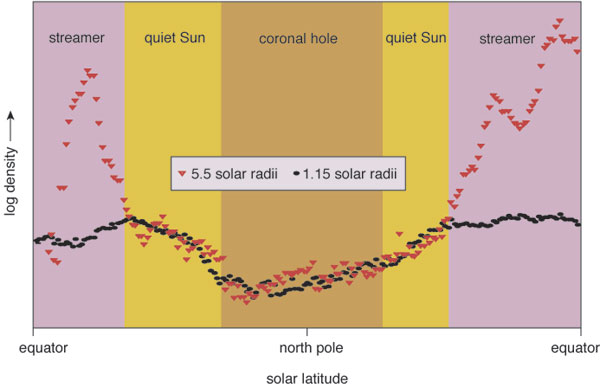
If we collect such density measures at different points on the plane of the sky of the corona, we can paint a picture of its overall density that's not possible with white light. When we first looked at the outer corona using the radio-occultation techniques, we found something that no one had expected: The coronal holes and the quiet Sun were clearly represented by variations in the electron density of the radially extended outer corona. In some sense these density variations are an "imprint" of the Sun, since they parallel features on its surface. This imprint could only have been carried to the outer corona by the solar wind. The observation was later confirmed by a white-light coronagraph on the SOHO spacecraft, which showed that the density of the outer corona was correlated with the density of the inner corona over a wide range of solar latitudes (Figure 7).
This is a fundamental connection between the Sun and the solar wind, and it is remarkable that it took so long for scientists to find it. In part, it seems likely that previous measurements were not sensitive enough to detect the low density of the coronal holes in the outer corona. But it's also the case that the relation is simply not obvious in white-light images of the corona. It only becomes evident in quantitative profiles of the corona that are plotted on a logarithmic scale (Figure 7). This is because density varies merely by a factor of 2 to 3 in the inner corona, but anywhere from 10 to 100 times in the outer corona. These differences between the inner and outer corona reflect the fact that as the coronal plasma moves away from the Sun, its density falls off quickly in the coronal holes and slowly in the bright coronal streamers. So the bright coronal streamers and their high-contrast boundaries overwhelm the tenuous, low-contrast imprint of the Sun, even when the measurements are sensitive. In fact, the boundaries of the streamers are typically mistaken for the polar coronal-hole boundaries. Although the polar-coronal hole boundary and streamer boundary are the same in the inner corona, with increasing distance from the Sun, the coronal-hole boundary extends radially, whereas the streamer boundary diverges. As a result, white-light images have misled scientists into believing that the polar coronal holes expand to lower latitudes as the solar wind blows out into space.
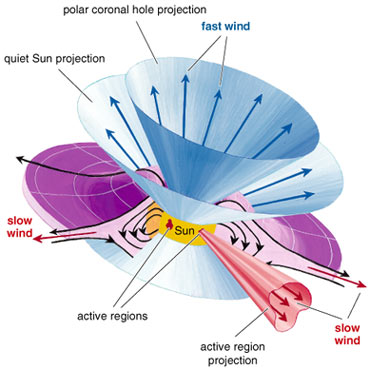
This misperception has also persisted in the interpretation of the solar wind measurements returned from the Ulysses spacecraft. Unfortunately, most scientists interpret the small daily variations in the solar wind seen by Ulysses at high solar latitudes as an indication that the wind originates only from the polar coronal holes, which were generally thought to be essentially structureless, and so consistent with a steady, fast wind. But Ulysses also detected daily variations in the solar wind's density that correspond to variations seen in white-light measurements of the inner corona made at the same time. Ulysses detected these variations when it was more than two astronomical units away (twice the distance between the Earth and the Sun), suggesting that remnants of the imprint of the Sun are carried far out into the distant solar wind.
This imprint could only have been transported there by nearly radial open field lines emanating from the coronal holes and the quiet Sun. Evidence for such open field lines can be found in the presence of small-scale structures in the solar corona. Since Ulysses detected the imprint in the fast wind, it must mean that the coronal holes are not its only source; the quiet Sun must also generate the fast wind (Figure 8).
Anyone who has seen a total eclipse knows that a photograph is no match for the human eye in its ability to see the full depth and subtlety of the solar corona. A camera simply cannot capture all of the low-contrast features that the eye can see. Thirty years ago, however, the French astronomer Serge Koutchmy thought of a way to process regular white-light images so that low-contrast structures could be seen. By employing a computer algorithm that traced changes in the density of the corona, Koutchmy was able to enhance white-light pictures of the corona to reveal small-scale filaments extending radially from the Sun (Figure 9). Koutchmy's work was generally ignored because no one understood how to interpret the images. However, the presence of these filaments was the first hint that regular white-light images were not showing us everything that's in the corona. Could there be even smaller structural features hidden in the corona?

Another radio-occultation technique that we use to investigate the structure of the solar corona relies on measurements of a radio wave's phase (Figure 6, right). The Deep Space Network engineers use the phase information to determine the velocity of a spacecraft, since the Doppler effect shifts the radio signal to longer or shorter wavelengths depending on its velocity relative to the Earth. For solar-wind scientists these Doppler measurements provide exquisite details of density gradients in the solar corona—that is, the spatial extent over which the plasma's density changes. It's the radio equivalent of Koutchmy's processed white-light images. In fact, reducing the sampling rate of the Doppler technique so that it corresponds to the spatial resolution of white-light images shows the same filamentary structures. At higher sampling rates, the technique suggests that filamentary structures extend to even smaller scales.
To date, the smallest filaments found by the Doppler method are about one kilometer across, more than 100 times smaller than those revealed by the best white-light images of the corona. Measurements of the Sun's magnetic field at this spatial resolution don't exist, but the Spanish astronomer Jorge Sánchez-Almeida indirectly estimated the smallest-scale magnetic fields from measurements of the Sun's surface and found they were about a kilometer across.
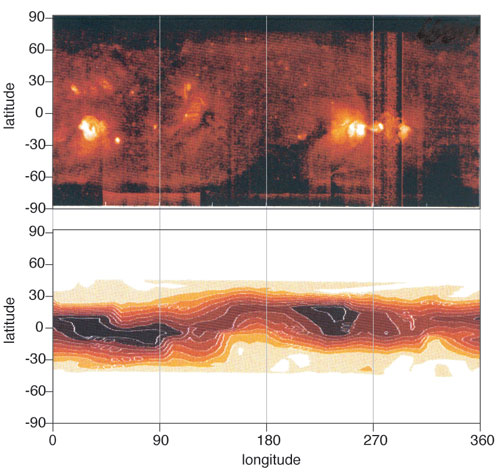
For the small-scale filaments to transport the Sun's imprint in the solar wind, they must extend radially from the Sun, and they should appear at all solar latitudes. And this is indeed what we find. In fact, the Doppler technique reveals that nearly radial open-field lines originate from the vicinity of active regions—quite a surprise, since active regions are usually thought of as being closed-field regions. Ulysses even detected the imprint of active regions in the solar wind more than one astronomical unit from the Sun (Figure 10).
The presence of radial filamentary structures at all solar latitudes is consistent with research on the corona's magnetic field. Although there are no direct measures of the corona's magnetic field, more than 20 years ago the American astronomer Jack Eddy inferred its structure by measuring polarized light in the corona. His results reveal that the corona's magnetic field is predominantly radial, but because they could not be explained by the magnetic field models, they have been largely forgotten. However, it is clear from our work that the radial magnetic field and the radial extension of the Sun's density imprint must be the same phenomenon (Figure 11).

This research suggests that there are two components to the coronal magnetic field—one radial and the other nonradial. The nonradial component is the traditional dipole-like field that is influenced and shaped by closed magnetic field lines, and is associated with the bright coronal streamers and polar plumes. The streamers taper to streamer stalks, and, unlike the Sun's imprint, only occupy a small volume of space. The streamer stalks appear to be the source of the slow solar wind. In contrast, the radial component is associated with the ubiquitous open field lines that originate from all regions of the Sun and carry its imprint in the solar wind.
The nonradial component of the magnetic field varies with the solar sunspot cycle, and it appears to be the coronal counterpart of the so-called strong field on the Sun's surface. The strong field is generated by the classical dynamo. In contrast, the radial component of the magnetic field may be the coronal counterpart of the weak field on the solar surface. The weak field does not vary much with the solar sunspot cycle and may be produced by a small-scale dynamo in the Sun.
Early investigations of the Sun's surface concentrated on sunspots and strong magnetic field regions. As the technology improved to allow high-resolution measurements, the rest of the Sun was unexpectedly found to be dynamic, with identifiable structures on a wide range of scales. Research on the solar wind is evolving in the same way. Although early studies concentrated on strong variations in the streamers, refined measurements of the solar corona and solar wind away from the streamers now reveal fine structures previously unrecognized.
This is a dramatic shift in our understanding of the solar wind. There are some who consider the new results controversial, perhaps heretical. This is curious and disturbing to us. Controversies usually arise from different interpretations of the same or similar data. In this case, the differences arise from entirely independent lines of observation. The traditional view is based on magnetic field models that link the measurements of the magnetic field on the Sun's surface with measurements of the solar-wind's velocity. The new view does not rely on a model and is based solely on observations of a single parameter, the plasma density. Detailed investigations of the solar-plasma density have been made using white-light imaging, in situ spacecraft, and radio-occultation techniques for more than four decades. Now these three observational approaches have been unified for the first time.
We could not have predicted that measurements of the solar wind's density, rather than measures of its velocity or the Sun's magnetic fields, would lead to exciting changes in our views of the origin of the solar wind and solar magnetism. But it is understandable, given that measurements of density are extensive and exquisite, and those of plasma flow and magnetic fields are relatively few. We have always looked to the Sun to understand the solar wind, and we did not suspect that discoveries about the Sun could be made by looking the other way around—at the solar wind. In spite of its relative proximity, our nearest star continues to surprise us, giving testimony to what the preeminent theoretical solar physicist Eugene Parker says: "The Sun is stranger than you think, displaying mysterious manifestations of the familiar laws of physics and posing new problems with every major advance in exploratory measurement."
Click "American Scientist" to access home page
American Scientist Comments and Discussion
To discuss our articles or comment on them, please share them and tag American Scientist on social media platforms. Here are links to our profiles on Twitter, Facebook, and LinkedIn.
If we re-share your post, we will moderate comments/discussion following our comments policy.